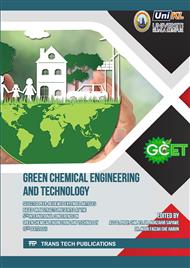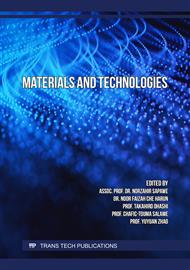[1]
M. Zendehdel, M. Ramezani, B. Shoshtari-Yeganeh, G. Cruciani, and A. Salmani, Simultaneous removal of Pb(II), Cd(II) and bacteria from aqueous solution using amino-functionalized Fe3O4/NaP zeolite nanocomposite, Environ. Technol. 28 (2018) 3689-3704.
DOI: 10.1080/09593330.2018.1485750
Google Scholar
[2]
M. Kavand, P. Eslami, and L. Razeh, The adsorption of cadmium and lead ions from the synthesis wastewater with the activated carbon: Optimization of the single and binary systems, J. Water Process Eng. 34 (2020) 101151.
DOI: 10.1016/j.jwpe.2020.101151
Google Scholar
[3]
Y. Tao, C. Zhang, and T. Lü, Removal of Pb (II) ions from wastewater by using polyethyleneimine-functionalized Fe3O4 magnetic nanoparticles, App. Sci. 10 (2020) 948.
DOI: 10.3390/app10030948
Google Scholar
[4]
B. M. Kaličanin, Determination of very toxic metal: Cadmium in natural water samples, Desalination, 249 (2009) 58-62.
DOI: 10.1016/j.desal.2009.03.006
Google Scholar
[5]
S. Wang and Y. Peng, Natural zeolites as effective adsorbents in water and wastewater treatment, Chem. Eng. J. 156 (2010) 11–24.
Google Scholar
[6]
T. Pambudi, E. T. Wahyuni, and M. Mudasir, Recoverable adsorbent of natural zeolite / Fe3O4 for removal of Pb (II) in water, J. Mater. Environ. Sci. 11 (2020) 69–78.
Google Scholar
[7]
M. Yuan, T. Xie, G. Yan, Q. Chen, L. Wang, Effective removal of Pb2+ from aqueous solutions by magnetically modified zeolite, Powder Technol. 332 (2018) 234–241.
DOI: 10.1016/j.powtec.2018.03.043
Google Scholar
[8]
M. Mudasir, K. Karelius, N. H. Aprilita, E. T. Wahyuni, Adsorption of mercury(II) on dithizone-immobilized natural zeolite, J. Environ. Chem. Eng. 4 (2016) 1839–1849.
DOI: 10.1016/j.jece.2016.03.016
Google Scholar
[9]
B. N. Huda, E. T. Wahyuni, M. Mudasir, Eco-friendly immobilization of dithizone on coal bottom ash for the adsorption of lead(II) ion from water, Results Eng. 10 (2021) 100221.
DOI: 10.1016/j.rineng.2021.100221
Google Scholar
[10]
M. Mudasir, R. A. Baskara, A. Suratman, K. S. Yunita, R. Perdana, W. Puspitasari, Simultaneous adsorption of Zn(II) and Hg(II) ions on selective adsorbent of dithizone-immobilized bentonite in the presence of Mg(II) Ion, J. Environ. Chem. Eng. 8 (2020) 104002.
DOI: 10.1016/j.jece.2020.104002
Google Scholar
[11]
D. E. Aminy, B. Rusdiarso, M. Mudasir, Adsorption of Cd(II) ion from the solution using selective adsorbent of dithizone-modified commercial bentonite, Int. J. Environ. Sci. Technol. 19 (2022) 6399–6410.
DOI: 10.1007/s13762-021-03570-1
Google Scholar
[12]
J. Jujarama, K. Wijaya, M. Shidiq, M. Fahrurrozi, and S. Suheryanto, Synthesis of biogasoline from used palm cooking oil through catalytic hydrocracking by using Cr-activated natural zeolite as catalyst, Asian J. Chem. 26 (2014) 5033–5038.
DOI: 10.14233/ajchem.2014.16299
Google Scholar
[13]
L. C. A. Oliveira, D. I. Petkowicz, A. Smaniotto, and S. B. C. Pergher, Magnetic zeolites: A new adsorbent for removal of metallic contaminants from water, Water Res. 38 (2004) 3699–3704.
DOI: 10.1016/j.watres.2004.06.008
Google Scholar
[14]
A. Mockovciakova, Z. Orolinova, M. Matik, P. Hudec, and E. Kmecova, Iron oxide contribution to the modification of natural zeolite, Acta Montan. Slovaca. 11 (2006) 353–357.
Google Scholar
[15]
K. L. Tan and B. H. Hameed, Insight into the adsorption kinetics models for the removal of contaminants from aqueous solutions, J. Taiwan Inst. Chem. Eng. 74 (2017) 25–48.
DOI: 10.1016/j.jtice.2017.01.024
Google Scholar
[16]
K. Y. Foo and B. H. Hameed, Insights into the modeling of adsorption isotherm systems, Chem. Eng. J. 156 (2010) 2–10.
Google Scholar
[17]
A. Mesdaghinia, A. Azari, R. N. Nodehi, K. Yaghmaeian, A. K. Bharti, S. Agarwal, V. K. Gupta, K. Sharafi, Removal of phthalate esters (PAEs) by zeolite/Fe3O4: Investigation on the magnetic adsorption separation, catalytic degradation and toxicity bioassay, J. Mol. Liq. 233 (2017) 378–390.
DOI: 10.1016/j.molliq.2017.02.094
Google Scholar
[18]
A. J. M. de Man, S. Ueda, M. J. Annen, M. E. Davis, R. A. van Santen, The stability and vibrational spectra of three-ring containing zeolitic silica polymorphs, Zeolites. 12 (1992) 789–800.
DOI: 10.1016/0144-2449(92)90051-p
Google Scholar
[19]
A. Gaffer, A. A. Al Kahlawy, D. Aman, Magnetic zeolite-natural polymer composite for adsorption of chromium (VI), Egypt. J. Pet. 26 (2017) 995–999.
DOI: 10.1016/j.ejpe.2016.12.001
Google Scholar
[20]
S. Jorfi, M. R. Shooshtarian, S. Pourfadakari, Decontamination of cadmium from aqueous solutions using zeolite decorated by Fe3O4 nanoparticles: adsorption modeling and thermodynamic studies, Int. J. Environ. Sci. Technol. 17 (2019) 273–286.
DOI: 10.1007/s13762-019-02350-2
Google Scholar
[21]
S. K. Milonjić, M. M. Kopečni, and Z. E. Ilić, The point of zero charge and adsorption properties of natural magnetite, J. Radioanal. Chem. 78 (1983) 15–24.
DOI: 10.1007/bf02519745
Google Scholar
[22]
K. S. Padmavathy, G. Madhu, P. V. Haseena, A study on effects of pH, adsorbent dosage, time, initial concentration and adsorption isotherm study for the removal of hexavalent chromium (Cr (VI)) from wastewater by magnetite nanoparticles, Procedia Technol. 24 (2016) 585–594.
DOI: 10.1016/j.protcy.2016.05.127
Google Scholar
[23]
Y. Li, Q. Yue, and B. Gao, Adsorption kinetics and desorption of Cu(II) and Zn(II) from aqueous solution onto humic acid, J. Hazard. Mater. 178 (2010) 455–461.
DOI: 10.1016/j.jhazmat.2010.01.103
Google Scholar
[24]
H. Radnia, A. A. Ghoreyshi, H. Younesi, G. D. Najafpour, Adsorption of Fe(II) ions from aqueous phase by chitosan adsorbent: equilibrium, kinetic, and thermodynamic studies, Desalin. Water Treat. 50 (2012) 348–359.
DOI: 10.1080/19443994.2012.720112
Google Scholar
[25]
K. T. Basuki and M. Muzakky, Adsorption of Am-241, Cs-137 and Sr-90 radionuclides with bentonite-humic acid immobilized yield, Indones. J. Chem. 10 (2010) 1–7.
DOI: 10.22146/ijc.21472
Google Scholar
[26]
U. Farooq, J. A. Kozinski, M. A. Khan, M. Athar, Biosorption of heavy metal ions using wheat based biosorbents–a review of the recent literature, Bioresour. Technol. 101 (2010) 5043–5053.
DOI: 10.1016/j.biortech.2010.02.030
Google Scholar
[27]
I. Langmuir, The constitution and fundamental properties of solids and liquids. Part I. Solids, J. Am. Chem. Soc. 38 (1916) 2221–2295.
DOI: 10.1021/ja02268a002
Google Scholar
[28]
R. G. Pearson, Hard and soft acids and bases, HSAB, Part 1: Fundamental principles, J. Chem. Educ. 45 (1968) 581.
DOI: 10.1021/ed045p581
Google Scholar
[29]
A. W. Adamson, Physical Chemistry of Surfaces, fifth ed., John Wiley & Sons, New York, (1990).
Google Scholar
[30]
V. B. A. S. Putri, Adsorpsi ion Cu(II) dan Cd(II) pada abu layang batubara yang diimobilisasi ditizon, Thesis, Universitas Gadjah Mada, (2019).
Google Scholar



